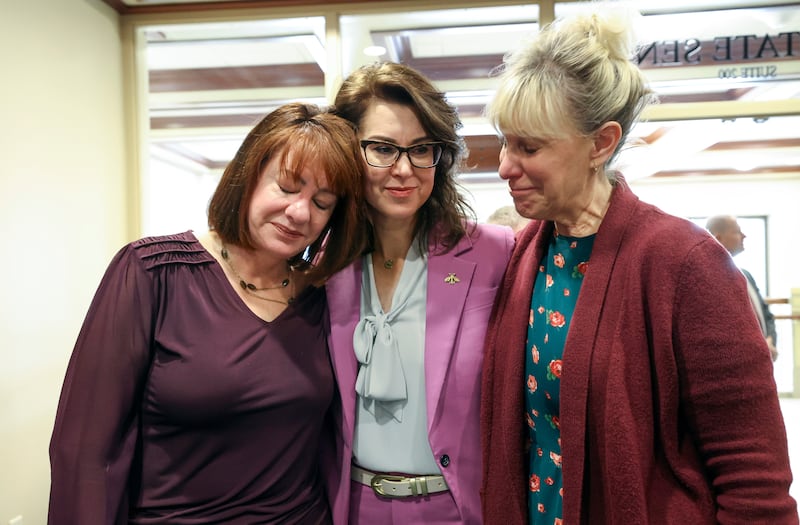Last week, Lt. Gov. Deidre Henderson spoke at the second annual A Bolder Way Forward summit about the progress Utah has made and still needs to make regarding several problems. She spoke first of learning from Martha Hughes Cannon the value of incremental progress. She said, “It can be tempting to get discouraged by the fact that we may think we’re not solving the problems — but let me offer my perspective. ... It’s OK that you are not seeing a problem get solved. An entire problem probably won’t ever get solved.” However, we can take “really meaningful” steps toward solving some of Utah’s thorniest problems.
One of the ways Utah has and will continue to make progress is in the area of domestic violence, and specifically, domestic violence homicide by intimate partners. “This is an area we can fix, that we can intentionally work on,” she said. It is something that can be eliminated. Henderson shared the story of her cousin, Mandy Mayne, who was shot 13 times by her ex-husband while she waited at a bus stop in 2022.
As a result of Mandy’s death and how it illuminated some of the gaps in a process of information and coordination that could have kept her safe, the Utah Legislature passed a bill in 2023 that would require law enforcement to perform lethality assessments for intimate partner violence calls. For those cases judged to be at high risk for death of the victim, the law requires police to connect victims with services at the time of the call. The bill also created a statewide database to facilitate sharing of information with law enforcement, across multiple jurisdictions, as well as track repeat offenders.
Latest data
From July 1, 2023, when Intimate Partner Lethality Assessment Protocols, or LAPs, went into place, through May 31, 2024, 10,189 LAPs were submitted by 144 agencies. Of those, 63% (6,454) of the LAPs were assessed as “potentially lethal.” Of the 6,454 victims connected to domestic violence services, only 500 refused those services, according to Henderson.
Thirty-two percent of the 10,000-plus LAPs (3,266) were assessed as “not potentially lethal,” and 460 (4%) were submitted for non-intimate partner violence. Fourteen percent (1,469) of the offenders were involved in prior LAPs, up from about 5% at the beginning of the program.
The Wasatch Front (Salt Lake, Utah, Davis and Weber counties) accounted for 78% of all LAP submissions since the beginning of the program. This number nearly coincides with population density, as the Wasatch Front represents 75% of the population in Utah. South Valley Services and YWCA combined received 43% of the LAP referrals.
From the LAP responses, 61% of victims reported that the aggressor is violently or constantly jealous, or controls most of the daily activities of the victim, the most common response. The second most common response, 55%, is that the victim has left or is separated from the aggressor after cohabitating. The responses that automatically designate a “potentially lethal” assessment are “aggressor has tried choking the victim” (38%), “aggressor has threatened to kill victim and/or children” (29%), “victim believes aggressor will try to kill them” (28%) and “aggressor used/threatened victim with a weapon” (22%).
How will Utah measure success?
Jen Campbell, the executive director of the Utah Domestic Violence Coalition, has been doing trainings and updates for law enforcement with Sgt. Jen Faumuina from the Utah Department of Public Safety. Feedback has been positive, said Mikaylee Sanchez Paz, the coalition’s prevention program coordinator and the point person on the coalition’s LAP work.
When asked about the data referenced by the lieutenant governor, Sanchez Paz said that since the July 1, 2023, implementation date, Utah is looking at about a 70% to 80% increase statewide in screenings and referrals. One of the successes Sanchez Paz says she can really see from this program is that “85% of referrals that service providers are receiving are for people who have never accessed any services prior to that lethality screen. That’s exactly what we wanted from this program,” to reach the people who have been missed, she said.
Lt. Gov. Henderson told the Deseret News that the increase in LAPs and the creation and use of the statewide database means more victims are getting support, law enforcement is better at identifying high risk individuals and more people are aware of the warning signs. “Success means seeing the number of people murdered by an intimate partner go down each year. Ultimate success is when the number is zero,” she said.


